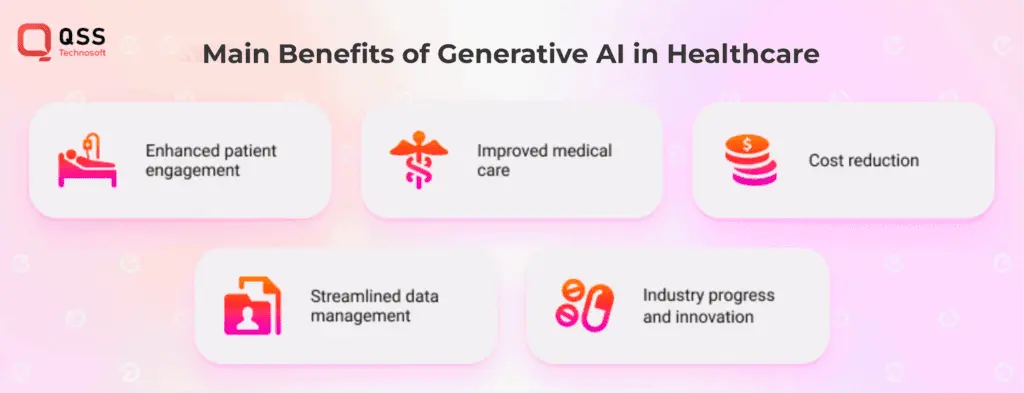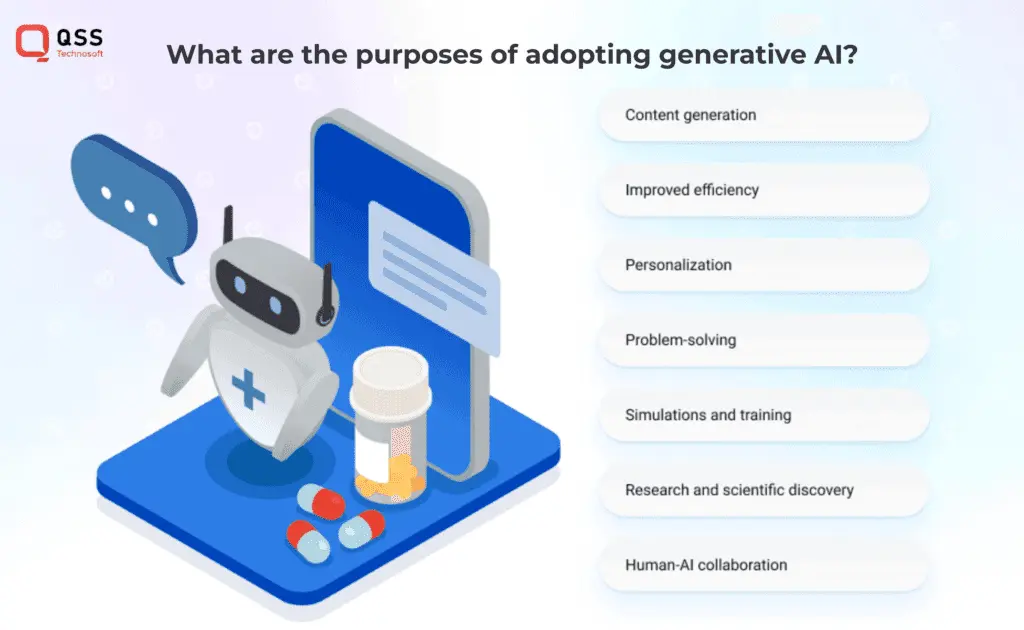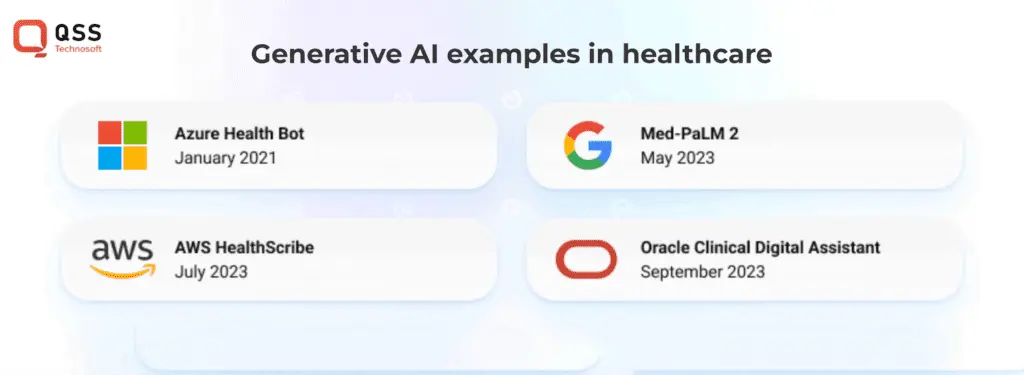Have you ever interacted with a chatbot that provided personalized healthcare recommendations based on your symptoms and medical history with Generative AI?
Or receive a treatment plan that was tailored specifically to your needs and preferences? Well, it may sound shocking but let us tell you it’s the future and these are just some examples of how Generative AI is revolutionizing patient-centric care.
In recent years, there has been a significant focus on patient-centric care in the healthcare industry. The shift towards personalized and patient-centred services has led to improved outcomes and higher patient satisfaction rates. One technology that has played a crucial role in enhancing healthcare interactions is Generative Artificial Intelligence (AI).
According to a report by Accenture, around 79% of healthcare executives believe that AI will be instrumental in improving patient experiences and outcomes.
What Is Generative AI?
Generative AI refers to the use of machine learning algorithms to generate personalized and context-aware patient interactions. These interactions can range from chatbots and virtual assistants to customized treatment plans and recommendations. By using the power of Generative AI, healthcare providers can create a more patient-centric approach that addresses individual needs and preferences.
Benefits of Generative AI in Patient-Centric Care:

Implementing Generative AI in healthcare interactions brings several benefits that contribute to improved patient experiences and outcomes. Some of these key benefits include:
1. Enhanced Patient Engagement: Generative AI-powered chatbots and virtual assistants provide patients with access to round-the-clock support, enabling them to engage with healthcare services whenever and wherever they need. This enhanced patient engagement ensures timely interventions and reduces the burden on healthcare professionals.
Example: Ada Health’s AI assistant is a chatbot that helps users assess their symptoms and provides personalized recommendations. It allows users to engage with healthcare services anytime, anywhere, providing timely interventions and reducing the burden on healthcare professionals.
2. Personalized Treatment Plans: The AI algorithms possess the capability to analyze vast amounts of patient data, including medical records, genetic information, lifestyle, and environmental factors. By using this data, healthcare providers can generate personalized treatment plans that are tailored to individual patients’ needs, preferences, and medical histories.
Example: IBM Watson Health’s oncology platform analyzes patients’ genetic information, medical records, and scientific research to create personalized treatment plans for cancer patients. This AI-powered platform guides healthcare providers in customizing treatments to individual patient’s needs and medical histories.
Read Our Old Blog : Exploring the Impact of Generative AI in Design and Content Creation
3. Improved Diagnostic Accuracy: AI-powered diagnostic tools can analyze medical images, lab results, and other patient data, providing healthcare professionals with accurate and timely diagnostic insights. This improves the speed and accuracy of diagnosis, leading to better treatment outcomes and reduced healthcare costs.
Example: Google’s DeepMind has developed an AI algorithm that analyzes medical images to detect and diagnose diseases such as diabetic retinopathy and breast cancer. What do you think about this? Isn’t this really a great measure?
4. Proactive Monitoring and Predictive Analytics: Generative AI can be used to continuously monitor patient data and identify patterns or anomalies. By using predictive analytics, healthcare providers can intervene at the right time, preventing potential health issues and ensuring proactive care.
Example: PhysIQ’s AI platform continuously monitors patients’ physiological data, such as heart rate and respiration, to identify patterns and anomalies.
5. Improved Patient Safety: Generative AI algorithms can analyze patient data and identify potential medication errors or adverse drug interactions. This reduces the risk of medical errors and enhances patient safety.
Example: Cerner’s AI-powered system helps identify medication errors and adverse drug interactions by analyzing patient data, such as medical records and medication history. The system alerts healthcare professionals to potential risks, reducing the risk of medical errors and enhancing patient safety.
Applying Generative AI in Patient-Centric Care:

To effectively apply Generative AI in patient-centric care, healthcare providers need to follow a systematic approach.
The following steps can guide the healthcare industry in implementing and maximizing the benefits of Generative AI:
Read Our Old Blog : Create Your Ultimate AI Toolbox for Interior Design and Architecture
Data Collection and Integration:
- Collecting diverse and high-quality datasets, such as medical records, lab results, and patient feedback through surveys.
- Incorporating patient-generated data from wearables and home monitoring devices to provide a comprehensive view of the patient’s health.
- Keeping up with emerging data sources, including genetic testing and social determinants of health, to gather a holistic understanding of patients’ conditions.
Algorithm Development and Training:
- Developing machine learning algorithms that can generate personalized treatment plans, symptom assessments, and educational content.
- Training the algorithms using collected datasets, incorporating patient preferences, and fine-tuning the algorithms based on user feedback through surveys.
- Exploring advanced AI techniques, such as natural language processing and deep learning, to improve the context-awareness and accuracy of the generated interactions.
Integration with Existing Systems:
- Seamlessly integrating Generative AI tools into existing healthcare systems like electronic health records (EHR) platforms and telehealth applications.
- Ensuring interoperability and data exchange between different systems to enable easy access and utilization of AI-generated patient interactions.
- Incorporating patient feedback through surveys to optimize the integration of Generative AI tools with existing systems and workflows.
Clinical Validation and Regulatory Compliance:
- Conducting rigorous clinical validation studies to assess the accuracy, reliability, and effectiveness of the generated AI interactions.
- Ensuring compliance with ethical standards and regulatory guidelines, such as HIPAA, to protect patient privacy and confidentiality.
- Staying updated with evolving regulations and guidelines in AI-driven healthcare technology to maintain regulatory compliance.
Continuous Improvement and User Feedback:
- Fostering a culture of continuous improvement by actively seeking user feedback through surveys and user testing.
- Incorporating patient and healthcare professional insights to modify and enhance AI algorithms for better personalization and user experiences.
- Staying informed about emerging trends in Generative AI and healthcare technology to adapt and optimize patient interactions and outcomes.
A Look at Three Innovative Projects For Enhancing Healthcare Communication and Collaboration
These projects have been successfully implemented by our team at QSS Technosoft, and they have made a significant impact on community care organizations and hospitals.
- Community Care Communication App: This project focuses on improving communication and collaboration within community care organizations. The app provides a platform for healthcare professionals, caregivers, and patients to exchange vital information, coordinate care plans, and track patient progress.
It streamlines communication and enhances the overall efficiency of community care operations. For more detailed information, you can refer to the case study link.
- Community Care App: This project is designed to optimize community care services by integrating various functionalities into a single platform. The app enables healthcare providers to schedule appointments, manage patient records, and facilitate seamless 3adcommunication between care teams.
It also allows patients to access their medical information, receive reminders, and smoothly interact with their healthcare providers. To red deeper into this project, you can visit the case study link.
- Hospital Communication: This hospital communication project aims to enhance communication and collaboration within hospitals and healthcare facilities. The solution offers a comprehensive communication platform that enables healthcare professionals to securely exchange messages, share files, and communicate about patient care in real-time.
It helps to streamline workflows, improve coordination, and optimize patient outcomes. For a more detailed understanding of this project, you can explore the case study link.
Examples of Generative AI in Healthcare:

Generative AI has already begun to transform healthcare interactions. Some notable examples include:
Chatbots for Triage and Symptom Assessment: AI-powered chatbots are being used to triage patients based on their symptoms, providing initial assessments and recommendations. This improves access to healthcare services and streamlines the patient journey.
Virtual Assistants for Patient Education: Virtual assistants can generate personalized educational content for patients, providing them with valuable information on treatment plans, medication reminders, and lifestyle modifications. This empowers patients to actively participate in their own care.
Decision Support Systems for Physicians: Generative AI algorithms can analyze patient data and provide physicians with evidence-based treatment recommendations. This enhances clinical decision-making and reduces the variability in care.
Improved Medical Image Analysis: Generative AI algorithms are now being used to analyze medical images such as X-rays, CT scans, and MRIs. These algorithms can detect abnormalities, assist in diagnosis, and even generate 3D models for surgical planning.
Personalized Treatment Generation: Generative AI algorithms can analyze large amounts of patient data and medical research to generate personalized treatment plans for individual patients. This includes recommending specific medications, and dosages, and even predicting treatment outcomes.
Conclusion:
Generative AI is revolutionizing healthcare interactions by enabling patient-centric care that is personalized, context-aware, and accessible. With a systematic approach to implementation and continuous improvement based on user feedback, Generative AI has the potential to reshape the future of healthcare, leading to improved patient outcomes and higher satisfaction rates.
If you’re interested in exploring how Generative AI can improve patient-centric care in healthcare, feel free to contact QSS Technosoft. Our team of experts can provide you with advanced AI-powered solutions that can streamline healthcare services, enhance patient engagement, and improve health outcomes. Contact us today to schedule a consultation and learn more about our services.
We are proud to mention that our work has been recognized by leading B2B reviews and research platforms like GoodFirms, Clutch, MirrorView, and many more.


Patient-Centric Care: Enhancing Healthcare Interactions with Generative AI